Sacred Connections Scotland
The Celto-Himalayan connection
Barry Dunford
Could it be that the the European Celtic racial streaming originated, at least in part, in the remote recesses of South Asia, in the region of the high mountain range of the Himalaya (“Abode of Snows”)? The following information suggests this may have been the case.
Under the heading “Common Ground of European Celts & Indian Vedic Hindus”, published in the May 1994 issue of the magazine Hinduism Today is related: “Like two rivers cascading from the same mist-shrouded mountain, Celtic and early Vedic culture share astonishing similarities…. Celtic cosmology cognizes four interrelating worlds of existence: netherworld, earth realm; heavenly realm of dead and demi-gods; white realm of supreme Deities and energy source of stars. Vedic cosmology perceives three interrelating worlds-physical; astral world of dead and demi-gods; causal universe of Deities, Supreme Being and primal energy; plus a fourth netherworld…. Imagine a wide swath from Iceland, Ireland, the European west coast across southern Russia, the Caucus mountains, through Afghanistan and into India; that is the common ground for this unnamed mutual spiritual/cultural system…. Like the Vedas, the extant Old Irish literatures – memorized and transmitted through a 12- year training by an Irish bard/priest class who were the inheritors of the druids – are a window into Celtic thought and lifestyle. Again, like the early Vedas, the Old Irish sagas and hymns are at times locked in metaphor that we don’t hold the keys to. There are also vast gulfs of knowledge missing from the Old Irish literature…. What remained was a Europe brightly misted in folk wisdom and sagas and inlaid with thousands of temple sites, holy groves and springs, stoneworks, fortresses, towns, cremation and burial grounds, sacred rivers, mountain eeries, seaside grottoes and treasure lakes all bearing names, artifacts and wisdom of the Celtic Gods, druids and culture, and other Indo-European pantheons. Most of what is considered Christian Europe is actually pagan Europe. Christmas day (December 25th) was usurped and inaccurately fixed by Christians from the Roman festival of Mithra. It came in turn from the Celt festival of the winter solstice, an astronomical event the druids observed to set the exact beginning of the new solar year – the same calculation brahmins made in India.”
The Celto-Himalayan connection is further supported in an article entitled “Hindu and Celtic Culture are One” by Druuis Belenios Ategnatos who writes: “The Celtic peoples are defined for the purpose of this article as referring to those people who in the past spoke a language of the Celtic branch of the Indo-European language family and also lived according to the ancient culture considered to be that of the speakers of Celtic as based upon Celtic traditions and stories and on archeology…. In traditional histories of India like the Puranas and Brahmanas, it is pointed out that in addition to the kingdoms in northern India, there were kingdoms north of the Himalayas with the same culture as in India, which would be in the regions that we are considering for the Celtic people. Most important is the famous land of the Uttara Kurus, described as a spiritual paradise north of the Himalayas. Comparison of European Celtic culture with Hindu culture shows a large number of similarities between them…. Therefore, we have cultural evidence to back up the traditions and the archaeology.” (American Institute of Vedic Studies, vedanet.com)
It has been noted that there are close parallels between the priestly castes of the Celtic Druids and the Hindu Brahmans. In his work The Druids and Their Heritage (1978), Ward Rutherford states: “The Indo-European migrants who, about the beginning of the 15th Century BC, reached India were the ‘Aryan’ invaders, founders of Hinduism. There are numerous startling resemblances between Hinduism and Druidism…. there had emerged in Hinduism, as its intellectual leadership, the Brahmins: these must be Diogenes’ ‘Gymnosophists’. The late Myles Dillon, Professor of Celtic Studies at the University of Dublin, has drawn up a list of the similarities between Brahmins and Druids…. The Brahmins, like the Druids, were communal lawgivers. Both recognized either forms of marriage. Of the Brahmins, Max Weber says that they occupied the positions of princely-chaplains, and acted as counsellors and as theological teachers. They were to be found as singers of epics extolling the heroic and deriding the unworthy. All were functions of the Druids. Like Druidic doctrine, that of the Brahmins was originally transmitted by word of mouth…. Most importantly, both acted as advisers on ritual, placing great emphasis on its correct execution.”
A number of intriguing Celto-Vedic connections are recorded by Dorothea Chaplain, F. S. A. Scot., who says: “Near Loch Nell or Loch-a-Neala (as it was formerly called) in Argyll [Scotland], is a serpentine mound 300 feet long. The Gaelic word signifies the Lake of Swans, and the appellation suggests the name of Nila Sarasvati, whose chariot is drawn by Swans, or that of Nala, who is also connected with Swans. The hillock faces three of the five peaks of the holy mountain Ben Cruachan. On the mound at the head of the symbolic Serpent, if such it be, half-cremated bones were discovered, and legend associates it with the burial-place of Ossian, son of Fingal…..” (Matter, Myth, and Spirit or Celtic and Hindu Links, 1935)
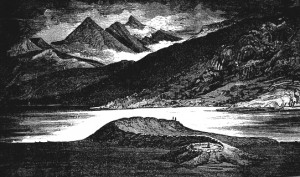
The Serpent Mound, near Oban, Scotland, c. 1870’s with the three peaks of Ben Cruachan
In her interesting late 19th century travel account entitled In the Hebrides (1886) C. F. Gordon Cumming, comments on her visit to “a huge Serpent-shaped Mound” which is to be found a few miles south of Oban on the west coast of Scotland, saying: “It is a very remarkable object, and one, moreover, which rises conspicuously from the flat grassy plain, that stretches for some distance on either side, with scarcely an undulation, save two artificial circular mounds, in one of which lie several large stones, forming a cromlech. These circles are situated a short distance to the south, to the right of the Reptile…. an artificial mound three hundred feet in length, forming a double curve like a huge letter S, and wonderfully perfect in anatomical outline…. On the head rests a circle of stones, supposed to be emblematic of the solar disc, and exactly corresponding with the solar circle as represented on the head of the mystic serpents of Egypt and Phoenicia, and in the great American Serpent Mound. Previous to 1871 there still remained in the centre of this circle, some traces of an altar…. The spine is, in fact, a long narrow causeway, made of large stones, set like the vertebrae of some huge animal. They form a ridge sloping off in an angle at each side, which is continued downwards with an arrangement of smaller stones, suggestive of ribs. The mound has been formed in such a position that the worshipper standing at the altar would naturally look eastward, directly along the whole length of the Great Reptile, and across the dark lake, to the triple peaks of Ben Cruachan. This position must have been carefully selected, as from no other point are the three peaks visible.”
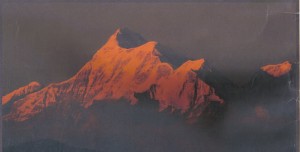
Mount Trishal (trident), Central Himalayas
This writer goes on to say: “This reverence for some Triune object, whether a triple-pointed hill, the junction ofthree rivers, or the neighbourhood of three lakes, seems to have been a marked characteristic of almost every ancient faith, and we may well believe that the Druids were not likely to pass by a great mountain, with its threefold summit towering heavenward, as if to draw thither the eyes and hearts of a race who were careful to consecrate all such natural types in their worship of Nature’s God. Attention was first called to this mound by Mr. Phene, and it was a knowledge of this tendency that first led him to examine minutely all the least-trodden glens in the neighbourhood of any such natural features, as for instance round the Eildon and Arran hills – seeking for traces which should mark the spot as sacred; and in each case, among other so-called Druidic remains, he has found just such mounds of reptile form as he was in search of – none, however, so remarkable as this strange old Serpent, which for so many centuries has lain here undisturbed, as if guarding the valley. All of these are more or less akin to the Reptile Mounds discovered in Ohio and Wisconsin by Messrs. Squier and Lapham, always in connection with sacrificial or sepulchral remains. One of these in particular is of an unmistakably serpentine form; and the position of the altar in the circle or oval at the head of the Serpent is identical with that of this Argyleshire mound, the head in each case lying towards the west. The American mound is, however, on a larger scale than its Scotch cousin, being altogether a thousand feet long. It points towards three rivers, thus indicating the reverence for the triple symbol, – another instance of which occurs on the hill known as Lapham’s Peak, on whose lofty summit three artificial mounds were found, carefully constructed of stone and earth, – materials which must have been transported thither with very great labour. Whatever may have been the origin of these huge serpent-shaped mounds, their existence seems to suggest a clue to the meaning of various ancient legends concerning enormous serpents which covered acres of land; the very fact of their dimensions being given in terms of land-measurement seeming to imply that the writers merely alluded in poetic terms to Ophite or Draconite temples where these symbols were worshipped…. Alexander the Great was taken to see a Sacred Dragon five acres in extent, lying in a low valley, surrounded by a high wall: to it the Indians offered sacrifices of flocks and herds. Strabo mentions two such Dragons in India, one mesuring eighty cubits in length, the other a hundred and forty.”
In her work, Matter, Myth, and Spirit or Keltic and Hindu Links, Dorothea Chaplain writes: “Cashmere, or Kashmir, is thought to have been one of the principal centres of Serpent worship…. At some time during the fifth century A. D., Doghra was Chief of the Druids in Britain; and it seems not unlikely that his name is in some way connected with the Dogras of Kashmir. The present Maharajah of Kashmir is a Dogra.” Interestingly, Jesus is said to have visited Kashmir where he was known by the name Isa. The gaelic name for Jesus is Iosa, and an oral tradition records the presence of Jesus and his mother Mary in the Western Isles of Scotland. This may be supported by the placename Eilean Isa (‘Island of Jesus’) which is located off the north west coast of the Scottish Isle of Skye. Close by is an ancient pre-Christian site of worship known as the Temple of Anaitis, dedicated to the ancient Mother Goddess of the Middle East and Asia. Throughout the Highlands and Islands of Scotland are to be found a number of Annat (Anaitis) placenames which denote sites that refer to a pre-Christian “mother church”. Moreover, Annat placenames, recording sites of religious worship, are also found in Kashmir.
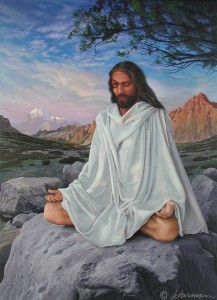
“Jesus meditating” near Mt. Kailash in Tibet ©Bruce Harman, used by permission. harmanvisions.com
In India and Tibet there are apparently records of the visit of Jesus to these countries, who was known there as Isa or Issa. After visiting Leh the capital of Ladakh which borders Tibet in the Himalayas, Henrietta Sands Merrick records in her book In the World’s Attic (1931): “In Leh is the Legend of Christ who is called ‘Issa’, and it is said that the monastery at Hemis holds precious documents fifteen hundred years old which tell of the days that He passed in Leh where He was joyously received and where he preached.” Furthermore, in The Drama of the Lost Disciples, the author George F. Jowett remarks: “The Rig-Vedas, the ancient religious books of India, were written 1500 B. C. and the Druidic religion antedated that of India, circa 1800 B. C. The wise men of India record the visit of Jesus among them, stating that he dwelt at Nepal. They also make several references to Britain as a great centre of religious learning; therefore, on several scores, Jesus would know of the eminence of Druidic religious wisdom.. Eastern and Western tradition claim Jesus completed his studies in Britain. This could be possible. At that time the Druidic universities were the largest in the world, both in size and in attendance, with a listing of sixty large universities and an average attendance of over sixty thousand students. This is affirmed by Greek and Roman testimony which states that the noble and wealthy of Rome and other nations sent their children to study law, science and religion in Britain.”
Writing about a possible Scoto-Vedic connection, Dorothea Chaplain relates: “The Kayashta, or Scribe caste, in Hindu India, claim descent from Yama, another name for whom is Samana. In Edinburgh the festival of Saman is still observed at a date which coincides with that of Yama; and it is in this famous city that the profession of Scribe, or Writer to the Signet, appears to have been evolved. King Arthur and his Knights of the Round Table of Britain and of Brittany, although allegorical, may also have been actual men. The Lothians and the valley of the Tweed are reminiscent of King Arthur and his retinue; and the great beacon, Arthur’s Seat (Chair or Throne) keeps his name fresh in the memory of the inhabitants of Edinburgh and the surrounding district…. The Grail is the Cauldron of Renovation. It is in possession of the Dagda and Brons (Bran) is the Keeper of it with his son Alain. The Cauldron is the receptacle of the Mother Goddess from which emanate the allegorical gods of the trinity. This is in accordance with the Aryan beliefs of both Kelts and Hindus…. The city of Edinburgh with its famous beacon is surrounded by a halo of romance. Arthur, in Scotland, seems to be identical with Aedh, or Aedhan, the Fair One, Keltic god of Fire. So conspicuous a figure in legend and romance as King Arthur, whose Seat is a landmark all over Edinburgh and far beyond, would seem also to be identified with Edinburgh itself. Is this beacon, now known as Arthur’s Seat, the gadi of Arthur, and one of the spots from which the mystic aidh, or Torch of the Vedas, spread its illuminating rays in all directions for the material and spiritual enlightenment of humanity? The word aidh in the Vedas is thought by Max Mueller to mean a torch.” Interestingly, a few miles south of Edinburgh is located the famed Rosslyn Chapel which has been likened to a Hindu temple.
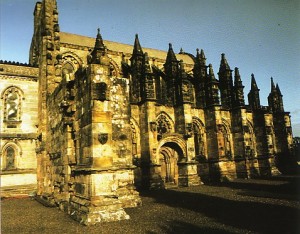
Rosslyn Chapel © Copyright “The Friends of Rosslyn”
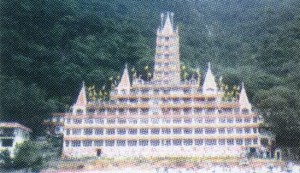
Rishikesh monastery, foothills of the Himalayas
Dorothea Chaplain further notes: “The island of Coll, the territory of a branch of Macleans, was formerly called Kelis, or Caolas. As in Bolivia, we find a name uncommonly like the Sanskrit Kailas, the sacred abode of Siva on the Himalayan Mountains…. Professor Watson translates ‘Slamannan’, in Central Scotland, as the ‘Upland of Manu’ and ‘Clackmannan’, the name of the smallest county of Scotland, as the ‘Stone of Manu’; both reminders of the great Law-giver who framed the caste system of the Hindus. On a map dated 1731 in the Public Library of Edinburgh it may be noticed that Islay, among the Western Isles of Scotland, is called the Island of Ila; and it is said of Helmsdale and the Helmsdale river in Sutherlandshire that they received their names form ‘Ila’, the name of the daughter of Manu.” She also says: “The name ‘Roy’, as a surname, is frequently met with among Hindus at the present time, and also sometimes in Scotland. Like the English Christian name, it means ‘king’.” And, moreover, “Hindu medical science is expounded in the Ayur Veda (Science of Life), one of the four supplementary Vedas, which is founded on the Rig Veda and the Atharva Veda. Dhanvantari made the declaration that ‘Health is positive, disease is negative’, and, turning to Scotland, we find the same principle expressed in the Gaelic proverb: ‘Man by nature is healthy’.” (Matter, Myth, and Spirit or Keltic and Hindu Links).
A 19th century researcher, Edward Kenealy, relates the following intriguing information: “In May, 1830, there was read at the Asiatic Society, a paper from the pen of Colonel Tod, on a gold ring of Hindu fabrication found at Montrose, in Scotland. The ring, the subject of this Essay, was in the possession of the Countess of Cassilis, and was dug up on the fort hill, near Montrose. The ring bears the miniature Lingam and Yoni, of Hindu adoration: round and over which is wreathed the Serpent; on either side is the Sacred Bull…. After suggesting the reasons which occur at first sight of the ring, for pronouncing it to be of Hindu origin, the author urged the similarity of religion once prevailing among all the tribes who peopled Europe from the East, as well as in India and Egypt…. The remainder of the paper was principally occupied with the arguments for ascribing a common origin to the Indo-Scythic martial races of India, and the early colonists of Europe.” (The Book of God, c. 1870)
In his magnum opus Anacalypsis or An Enquiry into the Origin of Languages, Nations and Religions, 1836, vol. II, Godfrey Higgins, a 19th century antiquary, states: “The Irish word Ogham and the Acham of the Sanscrit I have shown to be the same. When we consider this we shall not be much surprised to find the language of Scotland called Sanscrit, or Gael-doct, that is, learned Gael…. The language of the sacred island of Iona, of Scotland, is the Gaelic, but it is also called Shan Scrieu or Sanscrit…. While travelling lately by coach, in the Highlands of Scotland, an old gentleman told me the Gaelic language was called Sanscrit. On the coach-door being opened by the waiter, when we arrived at the next inn, the old gentleman asked him, in English, if he understood the Gaelic, and what was the name in Gaelic of the language: his answer was, without a moment’s hesitation, Sanscrit! There could be no imposition here, the old gentleman was an entire stranger in that part, and had not had an opportunity to speak to the waiter. He told me he spoke the language very well, as it was his native tongue, but he never had been taught to write it, therefore would not undertake to write it correctly; but he wrote it in my pocket book, Shan Scrieu…. We have found the word Gael or Gal in Ben-gal, and the Gaelic language in Scotland…. I believe there were many Sanscrit languages; it was an appellative term, and applied equally to the Gael or Celtic in India, and in Scotland. The Scotch Gael or Celtic, was the Gael of Singala, of Beni-Gael, of Point-de-Galle, of Oru Gallu, of the Syriac or Hebrew or Pushto. This very ancient and first-written syllabic language was, I cannot doubt, the Sanscrit or holy writ, and thus it is found in Scotland.”
Regarding a linguistic relationship between Sanscrit and Gaelic, Dorothea Chaplain comments: “Tri in Welsh, as in Sanskrit, stands for three. Triquetra, the Gaelic name for the trinity, appears to have etymological kinship with the Sanskrit word Trikuta – i. e. ‘having three peaks’. The three peaks of Ben Cruachan, which are visible from the Serpent’s Mound, and those of Eildon, whereon were the enchanted halls of Arthurian fame, remind one of Lanka mentioned in the Ramayana. ‘On the shores of the Southern sea there is a mount name Trikuta. On its brow is a beautiful and broad city built by Vicwakarma, named Lanka’…. The language of the Welsh is thought by some to resemble Sanskrit more nearly than that of any other European country. George Borrow maintains that Gaelic possesses more Sanskrit words than Cymric, and that they have more of the Sanskrit character, but in either case both are languages of the Kelts, as far as we know, and why should they have a Sanskrit foundation? The Welsh language is much more like Sanskrit than is Gaelic, owing to the fact that it is pronounced as it is spelt, which Gaelic is not.”
Dorothea Chaplain also observes: “The Kelts placed pillars on the tops of their hills, many of which are still visible. The pillars were dedicated to the Sun-god, Bal, or Bel, identical with Hu or Huan of Wales, and with Aedh…. Many upright stones, pillars and uncut monoliths are to be seen in India…. Bringing the stone, often from a great distance, sometimes from the Himalayas, no doubt on account of their great sanctity…. The stones are usually roughly cut, like those which one sees so frequently standing in fields in Wales and Cornwall.” This author further says: “In the Mahabharata, written some centuries after the Ramayana, mention is made of Sveta Dwipa, the White Island…. The ‘Old Sage’ instructs Narada as to the situation of the White Island, telling him that it lies to the north-west of Mount Meru, the abode of the gods and the demi-gods in Central Asia…. Scholars have been puzzled by this mysterious White Island, and they do not all take the same view about it. Some think it to be entirely mythical and symbolic, whilst others believe that it has a material significance, and may have been an actual island. Great Britain possesses many signs of the Boar incarnation in the form of symbolic representations, and it seems possible that the sages are referring to Alba. ‘The Isle of Britain’ is called by the Welsh ‘Y Wen Ynys’ – i. e. the White Island. The Holy Graal, or Sanct Greal, is said by Keltic authors to have been brought to the White Isle, and that ‘the White Isle’ is part of England.” (Matter, Myth, and Spirit or Keltic and Hindu Links).
Notably, in ancient times white was synonymous with being holy and spiritual. Could this be what the English visionary poet and mystic, William Blake, was intuitively sensing that the ancient British Isles was the original Holy Land when he penned: “All things Begin & End in Albion’s Ancient Druid Rocky Shore”. Furthermore, Comyns Beaumont in his Britain: The Key to World History (1948) says: “The ancient island of Britain is the key to world history in the past and she will be in the future.”
The geological rock strata of the West Highlands and Islands of Scotland is believed to be some of the oldest on the planet. Its archaic landscape clearly carries a primeval energy. A 19th century writer, Clara Bloomfield Moore, makes the pertinent observation: “The Himalayas, big and grand as they are, must represent mountains whose rise was a thing of a very ‘recent’ date, geologically speaking. This is proved, because we see rocks belonging to a relatively recent age, appearing as part and parcel of their lofty peaks. Very different is the case with the hills and mountains of, say, north-western Scotland. There you come upon peaks of an age well-nigh coeval with the world’s earliest settling down to a steady, solid, and respectable existence. The Scottish hills are the old, the very old, aristocrats of the cosmical circle; the Himalayas, Alps, and the rest, are the new race whose origin goes not further back than a generation, as it were.” (Keely and his Discoveries, 1893).
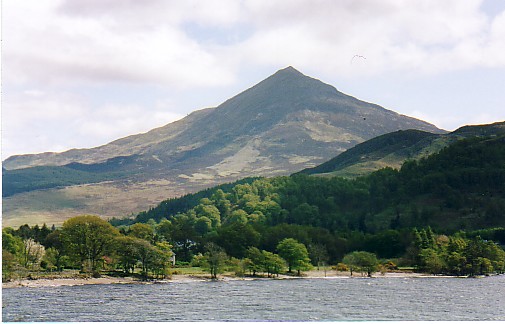
Schiehallion (“The fairy hill of the Caledonians”)
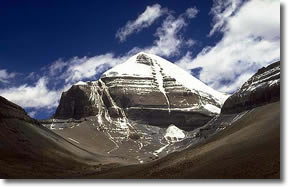
Mt. Kailash, Himalayas of Tibet. Courtesy of sacredsites.com
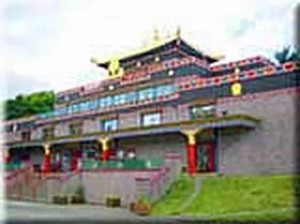
Samye Ling monastery, Scotland
Just as there appears to be a common Celto-Vedic racial heritage, so there may also be an energetic vibrational connection between the high Himalayas and the primeval mountain ranges of Scotland, which drew ascetic Brahmins to the former and Druidic magi to the latter. A more recent Celto-Himalayan connection is indicated by the founding in 1988 of the Tibetan Buddhist monastery, Samye Ling, near Eskdalemuir in Dumfriesshire, Scotland. This was subsequently supplemented with the establishing of a Tibetan Buddhist retreat centre on Holy Isle (sanctuary of the Celtic Saint, Molaise, during the 7th century A. D), off the east coast of the Scottish Isle of Arran.
What energetic and spiritual implications might the Celto-Himalayan connection precipitate in the future?